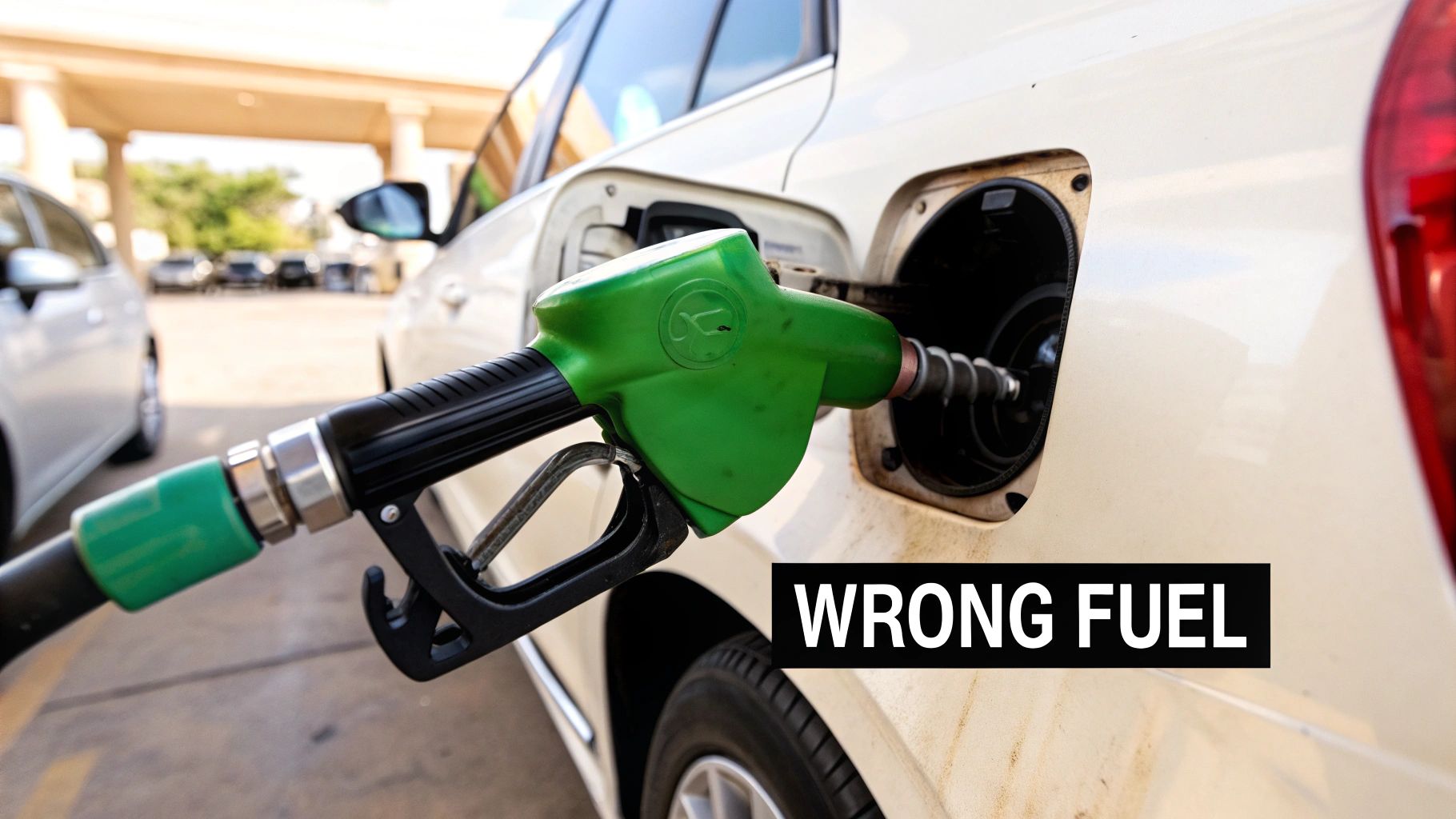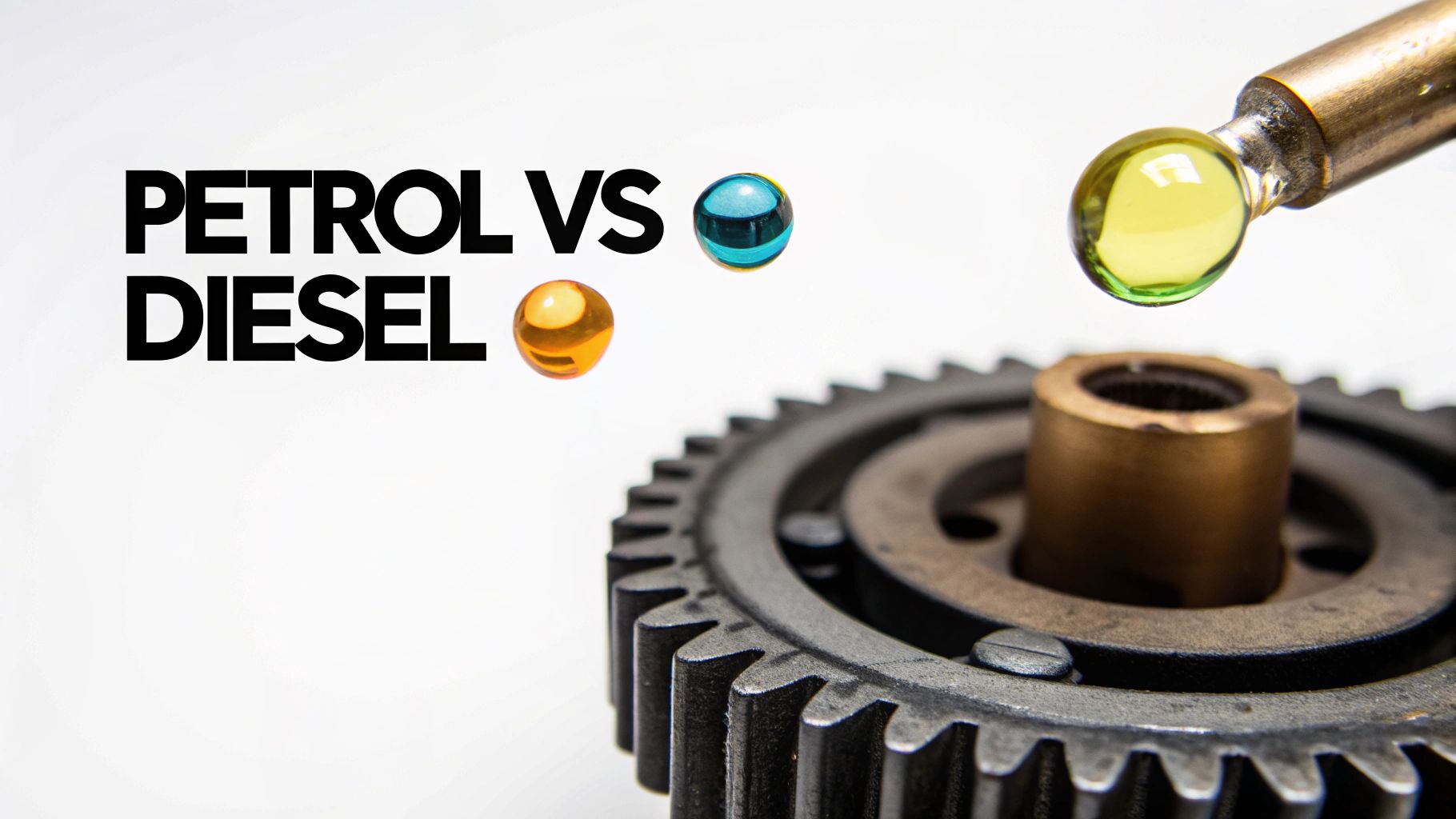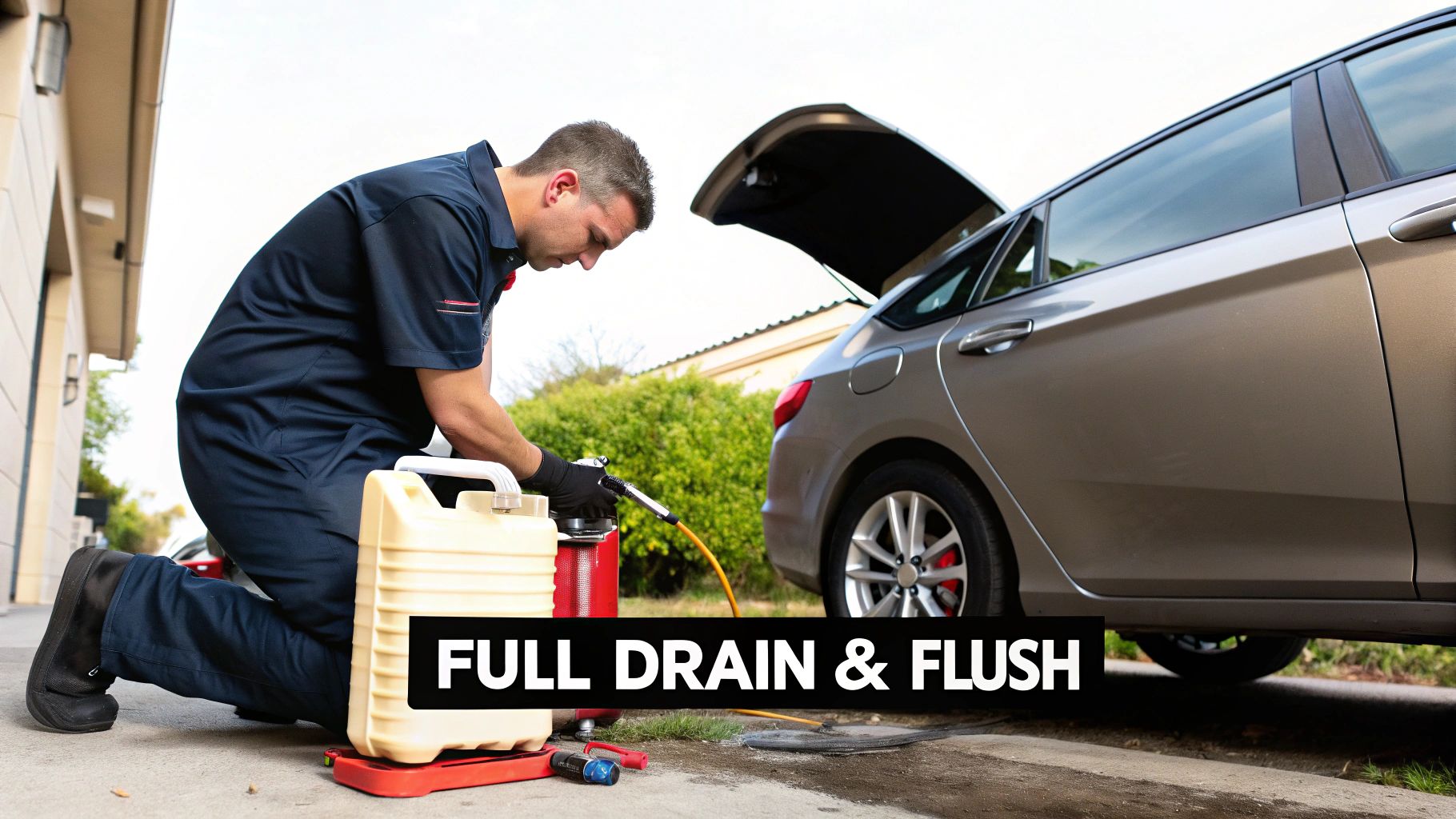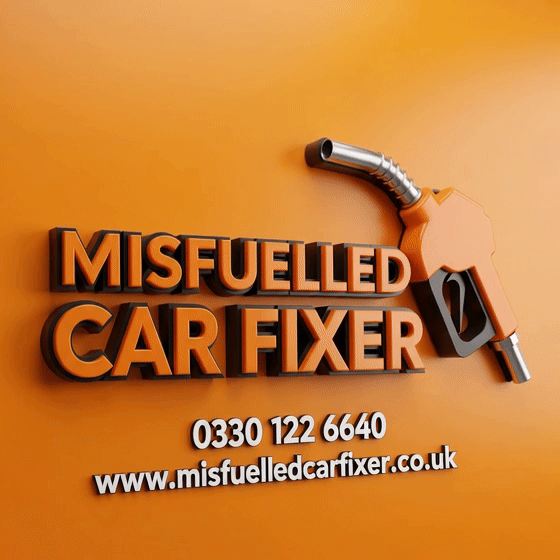What happens if you put petrol in diesel car: Repair costs
- Misfuelled Car Fixer

- 6 days ago
- 12 min read
It’s a heart-sinking moment every driver dreads: realising you've put petrol in a diesel car. This is one of the most serious and costly mistakes you can make at the pump, with the potential for catastrophic engine damage.
The most important thing to remember? Do not start the engine. That one simple decision can be the difference between a straightforward fix and a bill for thousands of pounds.
The Critical Mistake of Fuelling a Diesel Car with Petrol

To really understand why this is such a disaster, you need to know a fundamental difference between the two fuels. Diesel isn't just for combustion; it's also a thick, oily lubricant. It’s designed to coat and protect all the intricate, high-pressure components of your car's fuel system.
Think of your fuel pump and injectors like a high-performance Swiss watch. Every moving part relies on the lubricating properties of diesel to operate smoothly under incredible pressure. Petrol, on the other hand, is a solvent. When it hits your diesel system, it starts to strip away that vital, protective oily film.
The Immediate Mechanical Conflict
The moment that lubrication vanishes, things go wrong fast. The high-precision metal parts inside the fuel pump and injectors begin grinding directly against each other. This creates friction, which in turn generates tiny metallic particles known as 'swarf'. These fragments are then pumped right through the entire fuel system, causing rapid and often irreversible damage.
This common mistake often just comes down to a moment of distraction or not being familiar with the car you're driving. Taking a bit of time for understanding different car types and their fuel requirements can save you a world of hassle.
The core problem is simple: petrol acts as a solvent, while diesel acts as a lubricant. Introducing a solvent where a lubricant is needed creates a recipe for mechanical disaster, leading to component failure.
With around 10.96 million diesel cars still on UK roads in mid-2024, misfuelling is a persistent and expensive problem. In 2023 alone, it led to thousands of breakdown calls, with average repair bills falling anywhere between £500 and £2,500, all depending on how bad the damage was.
To get a quick sense of the stakes involved, have a look at this table. It breaks down the two main scenarios and what you could be facing.
Damage Potential at a Glance
This table offers a snapshot of what's at risk, highlighting why keeping the engine off is so crucial.
Scenario | Severity | Potential Damage | Estimated Cost |
|---|---|---|---|
Engine NOT Started | Minor | Fuel tank contamination | £200 - £500 |
Engine Started | Severe | Fuel pump/injector failure, engine damage | £1,500 - £5,000+ |
As you can see, the financial jump is massive. What starts as an inconvenient but manageable issue can quickly escalate into a repair that costs more than the car is worth, all because the ignition was turned.
Why Petrol Destroys a Diesel Engine

To really get your head around why petrol is so catastrophic for a diesel engine, you need to understand that diesel fuel does more than just burn. It’s not just about making the car go; it’s about keeping the engine's delicate mechanics happy. A key property of diesel is its oiliness, and modern diesel engines are designed to rely completely on this quality to survive.
This inherent oiliness is the lifeblood for the high-pressure fuel pump, a true masterpiece of engineering that works under incredible stress. Think of this pump as the heart of your fuel system. It’s built with components machined to tiny fractions of a millimetre, and it needs a constant supply of lubricant to keep going. That lubrication comes directly from the diesel fuel itself.
The Lubrication Failure
Imagine an expensive Swiss watch. All its tiny, intricate gears need special oil to move without friction. Now, what would happen if you flushed that oil out and replaced it with a cleaning solvent? The watch would grind to a halt in seconds, its delicate metal parts scraping against each other.
That’s a pretty good picture of what happens when petrol hits your diesel fuel pump. Petrol is a solvent; it cleans things. It immediately strips away the protective, oily film from all the pump's internal parts. Without that lubrication, you get extreme friction, causing metal to grind on metal and leading to catastrophic wear in a shockingly short amount of time.
As the pump tears itself apart, it creates tiny metal filings called swarf. These microscopic shards are then pumped at high pressure through the rest of the fuel system. They act like liquid sandpaper, scouring the fuel injectors and contaminating the fuel lines, filter, and potentially even the engine itself.
The Combustion Catastrophe
On top of the lubrication nightmare, there’s a second, equally serious problem: the way petrol burns. Petrol is much more flammable than diesel and is designed to be ignited by a spark plug at a specific time.
Diesel engines don't have spark plugs. They use compression ignition, a completely different process.
Step 1: First, the engine's piston compresses air inside the cylinder to an incredibly high pressure.
Step 2: This extreme compression superheats the air to a temperature high enough to ignite fuel instantly.
Step 3: At the perfect moment, the injectors spray in a fine mist of diesel, which spontaneously combusts in the hot air, pushing the piston down to create power.
When you introduce petrol into this high-compression chamber, it doesn’t wait for the right moment. It ignites far too early and uncontrollably, creating a violent explosion rather than a controlled burn. This is known as detonation or engine 'knocking'.
Instead of a smooth push, the piston gets hit with a sledgehammer-like shockwave. These repeated, violent jolts place enormous stress on the pistons, cylinder walls, and connecting rods. In the worst-case scenario, this can lead to cracked pistons or total engine failure. It's this one-two punch of lubrication failure and violent, premature combustion that makes misfuelling so incredibly destructive.
Recognising the Warning Signs of Misfuelling
So, you’ve driven off the forecourt with the wrong fuel in the tank. Your car isn't going to keep this secret for long. It will start sending out some very clear, and often very loud, distress signals. Knowing what to look and listen for is absolutely critical – the faster you spot the problem, the quicker you can pull over and prevent some seriously expensive damage.
The first thing you’ll likely notice is a loud, metallic knocking or clattering sound from the engine. This isn't your usual engine hum; it's a harsh, jarring noise. It’s the sound of petrol igniting way too early and violently under the intense pressure of a diesel engine. Think of it as tiny explosions happening at the wrong time, sending shockwaves through the engine’s most delicate parts.
Visual and Performance Clues
Beyond the alarming noises, keep an eye on your mirrors. You might see excessive smoke pouring from the exhaust. This isn't just a bit of vapour; we're talking about thick white or grey smoke. It's a direct symptom of unburnt fuel and the breakdown of lubrication inside the engine.
At the same time, you'll feel a dramatic loss of engine power. The car will feel like it’s wading through treacle. It’ll struggle to accelerate, start to judder, and misfire as it desperately tries to run on fuel it was never designed for. More often than not, this ends with the engine cutting out entirely, leaving you stranded.
And then there's the dashboard. Expect it to light up like a Christmas tree. The 'check engine' light or the engine management light (EML) will almost certainly flash on. This is your car's brain telling you in no uncertain terms that something is critically wrong. It’s a clear signal to stop driving, right now. For a more detailed look at these signs, check out our guide on petrol in diesel car symptoms and what to do next.
Every one of these symptoms—the noise, the smoke, the power loss, the warning lights—is a direct result of petrol’s thin, solvent-like nature clashing with a system built for oily, high-compression diesel fuel.
It’s a mistake that’s still surprisingly common. Even though there are about 2.8 million fewer diesel cars on UK roads now compared to 2019, misfuelling still makes up nearly 10% of all breakdown calls for diesels. That’s a stark reminder of how easy it is to do. As government analysis shows, this simple slip-up often leads to wrecked fuel pumps and injectors. You can read more about UK road diesel demand drivers in this report.
Ignoring these warning signs is a bit like trying to run a marathon on a broken leg. You’re only going to make the damage, and the final repair bill, a whole lot worse.
Your Immediate Action Plan After Misfuelling
That sinking feeling when you realise you've put petrol in your diesel car is a horrible one. But what you do in the next few moments can genuinely save you thousands of pounds in repairs. The key is to stay calm and act methodically. Panic is the enemy here.
The single most important rule, and I can't stress this enough, is: DO NOT START THE ENGINE. If you haven't turned the key or pushed that start button yet, leave it alone. Just this one simple action keeps the damaging petrol and diesel mixture contained safely in the fuel tank, away from your engine's delicate components.
If you only realised your mistake after starting the car or driving a short way down the road, don't worry. Just pull over as soon as it's safe and turn the engine off immediately. Every second it's running, it's pulling more of that solvent-like petrol through the fuel system, massively increasing the risk of serious damage.
First Crucial Steps
Right, the engine is off and you're in a safe spot (hopefully, still at the pump). Here’s what to do next:
Do Not Turn on the Ignition: Don't even put the key in and turn on the electrics. On many modern cars, this can prime the fuel pump, which starts circulating the contaminated fuel before the engine even cranks.
Put the Car in Neutral: This just makes it much easier to push the vehicle to a safe parking space if you need to.
Tell the Petrol Station Staff: Let them know what's happened. They can close off the pump and will often help you move your car out of the way for other drivers.
This simple flowchart lays out the critical choice you have to make.

As you can see, keeping the engine off is the central decision that leads directly to a much safer, and far less expensive, outcome.
Your main goal right now is damage limitation. By not starting the engine, you stop the contaminated fuel from ever getting to the high-pressure fuel pump and injectors – by far the most expensive parts to replace.
Who to Call for Help
This isn't a job for a DIY fix or even your local garage mechanic. You need a specialist wrong-fuel recovery service. We are mobile units with certified, purpose-built equipment designed to handle and dispose of contaminated fuel safely and in line with strict environmental regulations. We'll come directly to you, whether you're stuck on the forecourt or stranded on the side of the road.
A professional service like ours will carry out a complete fuel drain, flush the entire system to get rid of any lingering petrol, and then put the correct diesel fuel back in. For a closer look at what's involved, you can read our guide on the safe steps and tips for how to drain a fuel tank. Trying this yourself is genuinely dangerous and can easily cause more damage. Make the right call and let an expert sort it out.
How Professionals Fix a Misfuelled Car

When you make that call for help, you’re not just getting someone to pump out the bad fuel. A professional misfuelling service is a meticulous, step-by-step procedure designed to purge every last trace of petrol from your car's delicate system. Think of it as a full detox for your vehicle, making sure no damaging contaminants are left to cause havoc later on.
The first thing our technician will do when they get to you is make the whole area safe. Petrol fumes are incredibly flammable, so they’ll manage any potential spills and check for ignition sources. Your safety, and theirs, is always the top priority.
Once everything is secure, the real work begins. This is a world away from sticking a hose in the tank and siphoning. We use specialist, industry-approved pumping equipment to drain the entire contents of your fuel tank into a secure container, ready for environmentally safe disposal.
The Fuel System Decontamination
Just emptying the tank is only half the battle. The real value in calling a professional comes from the deep clean of the entire fuel system – something a simple DIY drain just can’t replicate.
Here's how we do it:
Flushing the Fuel Lines: We systematically flush the lines running from the tank to the engine, pushing out any trapped petrol. This is absolutely critical, as even a tiny amount of petrol reaching the high-pressure pump can cause serious damage.
Replacing the Fuel Filter: The fuel filter’s job is to trap dirt, but right now, it’s soaked in the wrong fuel mix. We always replace it with a brand-new one. Skipping this is like having a shower and putting your dirty clothes back on – it just re-contaminates the system immediately.
A professional fuel drain isn't just about emptying the tank. It’s a meticulous decontamination that makes sure the fuel pump, lines, filter, and injectors are completely free of the harmful petrol solvent before clean diesel is put back in.
What Happens if You’ve Started the Engine?
If you ran the car, even for a moment, the process gets a bit more involved. The technician will need to flush the high-pressure pump and injectors with clean diesel. This helps dislodge any tiny metal fragments (known as swarf) created by the lack of lubrication and gets protective diesel back where it needs to be. Sometimes, we’ll also plug in diagnostic tools to check for any fault codes logged by the car’s computer.
With so many diesel cars still on the road in the UK, this is a common and costly mistake. The average cost of a professional repair after misfuelling often climbs above £1,000, and that’s without accounting for major engine work that could write the car off. You can get more insight into the future of the UK’s diesel fleet to see why this problem isn't disappearing anytime soon.
Finally, with the system clean and a new filter fitted, the technician will add the correct diesel fuel back into your tank. They’ll then prime the system to get fuel flowing correctly before starting the engine. They’ll let it run for a few minutes, listening and checking that everything sounds and feels right, before giving you the all-clear to safely drive away.
Common Misfuelling Questions Answered
Even after getting your head around the mechanics of what happens when petrol meets diesel, you've probably still got a few nagging questions. It’s a stressful situation, and clear, straight-up answers are what you need to make the right call. Let's tackle the most common queries we hear from drivers every day.
Will a Small Amount of Petrol Really Cause Damage?
In a word, yes. It's surprising how much damage even a small amount of petrol can cause. While a tiny splash is obviously better than a full tank, the moment petrol mixes with diesel, it starts stripping away the diesel's essential lubricating qualities. Think of it as watering down the engine oil that’s meant to protect critical components.
Most mechanics and engineers agree that once the mix hits more than 5% petrol, you're in the danger zone. At that point, you risk causing accelerated wear on the high-pressure fuel pump and injectors. To be completely safe and sidestep expensive problems down the line, the only real solution is a professional drain and flush, no matter how small you think the mistake was.
Does My Car Insurance Cover Misfuelling?
This is a big one, and unfortunately, the answer is often "it depends." Some fully comprehensive policies have an ‘accidental damage’ clause that covers misfuelling, which is great. However, many standard policies specifically exclude it, meaning the bill lands squarely in your lap.
Don't just assume you're covered. Your first step should be to dig out your policy documents or, better yet, call your insurer directly. You'll also want to weigh up the cost of your excess against the repair bill and think about how a claim might affect your no-claims bonus.
How Can I Avoid Putting the Wrong Fuel In My Car?
As with most things, prevention is a whole lot better than cure. The simplest and most powerful habit is to just take a breath and double-check the pump nozzle and the label on your fuel flap before you squeeze the trigger. It takes two seconds.
Here are a few other tried-and-tested tips to keep you on the straight and narrow:
Ditch Distractions: Put your phone away at the pump. A moment of inattention is the number one reason people misfuel.
Build a Habit: If you switch between cars often – maybe a diesel for personal use and a petrol work van – make a conscious mental check of the fuel type part of your routine every single time you fill up.
Get a Gadget: For total peace of mind, you can buy a misfuelling prevention cap. These clever devices replace your standard cap and are engineered to physically block the smaller petrol nozzle from ever entering your wider diesel filler neck.
Is Putting Diesel in a Petrol Car Just as Bad?
While it’s still a problem that needs a fuel drain to sort out, putting diesel in a petrol car is generally less destructive. A big part of this is purely physical – the diesel pump nozzle is bigger than most petrol filler necks, making it a much harder mistake to make in the first place.
If you do manage it, the oily diesel won't ignite properly. Instead of the catastrophic friction damage we see with petrol in a diesel engine, it will clog up the fuel system and foul the spark plugs. The result? The engine will run terribly, pump out clouds of smoke, and eventually cut out. It’s messy, but it’s rarely a mechanical catastrophe. To get a better sense of the different scenarios and repair bills, have a look at our complete UK guide on the cost of putting the wrong fuel in your car.
If you've had that sinking feeling at the pump and need professional help right now, don't panic. Misfuelled Car Fixer provides a 24/7 mobile fuel drain service across Suffolk and the surrounding areas. Give us a call, and we'll get you back on the road safely and quickly. Find out more at https://www.misfuelledcarfixer-suffolk.co.uk.



Comments